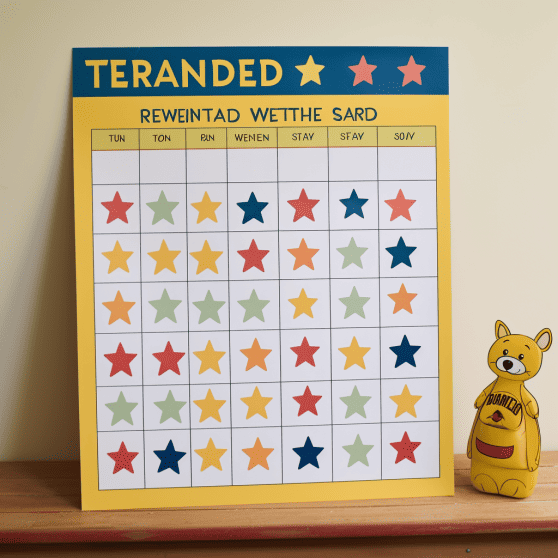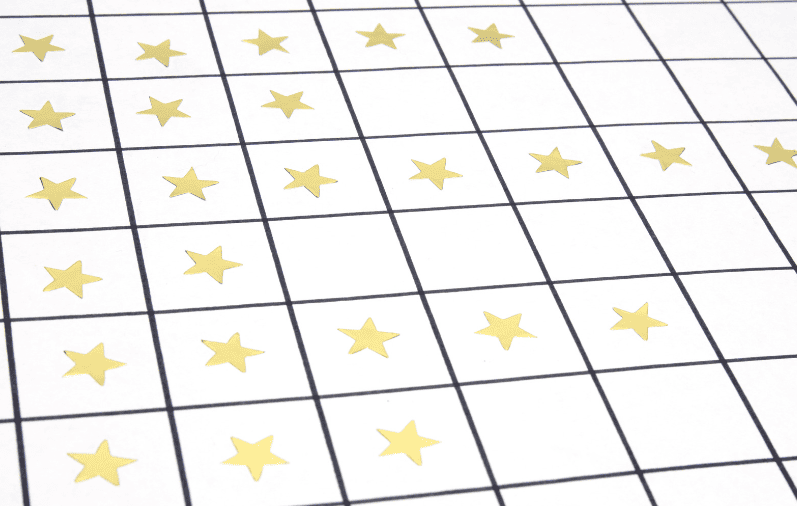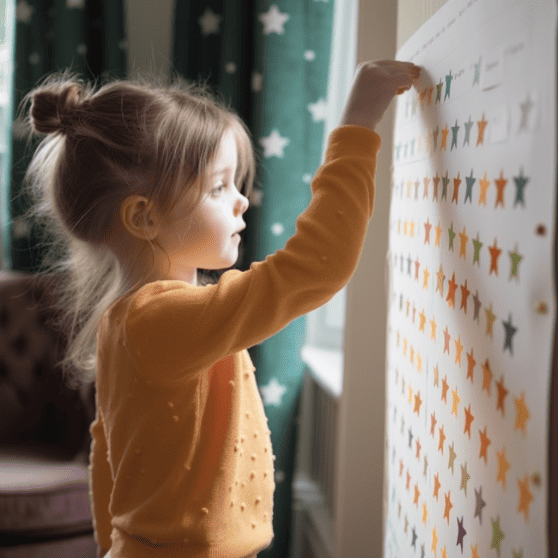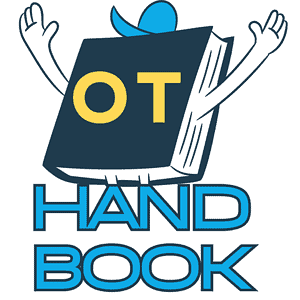
A reward chart is a visual tool used during toilet training to encourage and reinforce positive behaviour.
It typically consists of a chart or grid with specific tasks or goals for toilet training that the child is expected to complete.
Each time the child completes a task, such as using the toilet instead of a diaper, they receive a sticker or other small reward on the chart.
As the child accumulates more stickers or rewards, they can receive a larger reward, such as a special toy or treat.
The reward chart can help motivate children to learn and adopt new behaviours related to toilet training by providing a visual representation of their progress and success.
It can also reinforce the child’s efforts and help build their self-esteem and confidence.
Here’s a detailed step-by-step guide on how to use a reward chart in toilet training:
Step 1: Prepare the reward chart

First, you must create a chart or grid that lists specific toilet training tasks or goals your child needs to complete, such as sitting on the potty, using the toilet, washing hands, or staying dry throughout the day.
You can use a pre-made reward chart or create your own using your child’s favourite colours, stickers, or pictures. Make sure the chart is visible and accessible to your child.
Click here for more details on creating your own reward chart for toilet training.
Or you can skip the hassle of creating one by using a pre-made toilet training reward chart instead. You can download a free toilet training reward chart by clicking here.
However, the free version does come with watermark. If you are interested, you can download the premium version of toilet training reward chart WITHOUT watermark by clicking HERE.
Step 2: Decide a reward system

Next, you must choose a reward system appropriate for your child’s age and interests.
You can use small rewards such as stickers, stamps, or tokens for each task completed and more significant rewards such as toys, books, or special activities for a certain number of completed tasks or a set amount of time without accidents.
It is important to encourage your child to participate and choose their rewards.
Make sure the rewards can motivate your child and that your child knows what to expect.
Click here to find out the best rewards ideas for toilet training reward chart system.
Step 3: Set the rules

Introduce the reward chart to your child, and explain how it works, including what they need to do to earn rewards and how often rewards will be given.
For example, they will earn their ‘real’ reward at the end of the week after accumulating stickers for each toileting task for 5 consecutive days.
Remember the time frame you set is not necessarily fixed to 5 days, it can be 6 days or even the whole week. It’s up to you to decide what is achievable for your child.
Starting from a smaller number, like 3 days, is always recommended, especially if your child is in the very early stages of toilet training.
Keep the rules simple and clear for your child to understand.
Emphasize the positive aspects of toilet training and how the chart can help them achieve their goals.
Step 4: Track progress

Each time your child meets the criteria for a behavior, mark it on the chart with a sticker or a checkmark.
Please remind your child to always check the chart and add stickers on the chart after completing a task.
Use the chart consistently and positively, praising and encouraging your child for their successes rather than punishing them for their mistakes.
Step 5: Give rewards

Give them the ‘real’ reward at the end of the week or when your child reaches a specific goal.
Rewards can be in the form of anything your child likes, such as toys, books, food, or special activities.
Adjusting the reward chart system

To maintain the reward chart system, you may need to adjust the chart as needed to reflect your child’s progress and challenges.
Suppose your child struggles with a particular task. In that case, you can break it down into smaller steps or provide additional support or encouragement.
If your child is progressing well, you can increase the difficulty of the tasks or adjust the rewards to provide a more significant challenge.
Conclusion
A reward chart can be an effective and positive way to encourage and reinforce good behavior during toilet training.
However, as your child progresses and becomes more proficient in toilet training, you need to gradually phase out the reward chart so they do not become dependent on rewards to present good behavior.
Instead, you can rely on natural consequences and positive reinforcement to encourage good behaviour.
Natural consequences means you explain to your child the negative consequences that comes from behaving negatively. For example, they will feel uncomfortable if they wet their pants.
You can also use other form of ‘positive reinforcement’ technique such as verbal praise and hi-5 to encourage your child to maintain their good behaviour.
To learn more about how to gradually phasing out a reward chart for toilet training, you can check out this article.
Last but not least, always remember to keep the toilet training process consistent, positive, and flexible, and celebrate your child’s progress and success.
I hope this article is helpful to you, and if you like it, you may check out my other articles from this blog. Thanks for visiting my blog!


